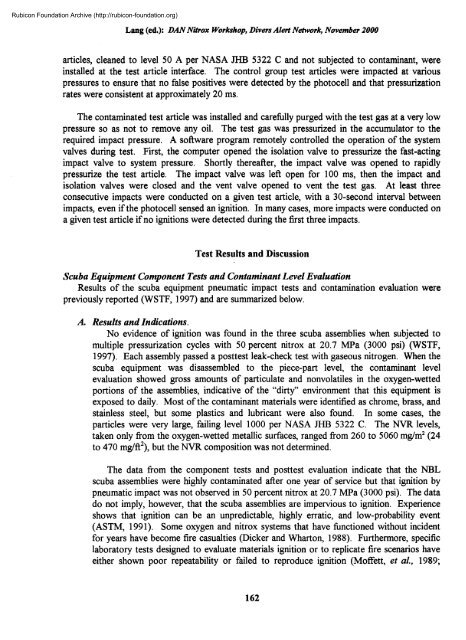Nitrox workshop dings - Divers Alert Network
Nitrox workshop dings - Divers Alert Network
Nitrox workshop dings - Divers Alert Network
You also want an ePaper? Increase the reach of your titles
YUMPU automatically turns print PDFs into web optimized ePapers that Google loves.
Rubicon Foundation Archive (http://rubicon-foundation.org)Lang (ed.): DAN <strong>Nitrox</strong> Workshop, <strong>Divers</strong> <strong>Alert</strong> <strong>Network</strong>, November 2000articles, cleaned to level 50 A per NASA JHB 5322 C and not subjected to contaminant, wereinstalled at the test article interface. The control group test articles were impacted at variouspressures to ensure that no false positives were detected by the photocell and that pressurizationrates were consistent at approximately 20 ms.The contaminated test article was installed and carefully purged with the test gas at a very lowpressure so as not to remove any oil. The test gas was pressurized in the accumulator to therequired impact pressure. A software program remotely controlled the operation of the systemvalves during test. First, the computer opened the isolation valve to pressurize the fast-actingimpact valve to system pressure. Shortly thereafter, the impact valve was opened to rapidlypressurize the test article. The impact valve was left open for 100 ms, then the impact andisolation valves were closed and the vent valve opened to vent the test gas. At least threeconsecutive impacts were conducted on a given test article, with a 30-second interval betweenimpacts, even if the photocell sensed an ignition. In many cases, more impacts were conducted ona given test article if no ignitions were detected during the first three impacts.Test Results and DiscussionScuba Equipment Component Tests and Contaminant Level EvaluationResults of the scuba equipment pneumatic impact tests and contamination evaluation werepreviously reported (WSTF, 1997) and are summarized below.A. Results and Indications.No evidence of ignition was found in the three scuba assemblies when subjected tomultiple pressurization cycles with 50 percent nitrox at 20.7 MPa (3000 psi) (WSTF,1997). Each assembly passed a posttest leak-check test with gaseous nitrogen. When thescuba equipment was disassembled to the piece-part level, the contaminant levelevaluation showed gross amounts of particulate and nonvolatiles in the oxygen-wettedportions of the assemblies, indicative of the "dirty" environment that this equipment isexposed to daily. Most of the contaminant materials were identified as chrome, brass, andstainless steel, but some plastics and lubricant were also found. In some cases, theparticles were very large, failing level 1000 per NASA JHB 5322 C. The NVR levels,taken only from the oxygen-wetted metallic surfaces, ranged from 260 to 5060 mg/m 2 (24to 470 mg/ft 2 ), but the NVR composition was not determined.The data from the component tests and posttest evaluation indicate that the NBLscuba assemblies were highly contaminated after one year of service but that ignition bypneumatic impact was not observed in 50 percent nitrox at 20.7 MPa (3000 psi). The datado not imply, however, that the scuba assemblies are impervious to ignition. Experienceshows that ignition can be an unpredictable, highly erratic, and low-probability event(ASTM, 1991). Some oxygen and nitrox systems that have functioned without incidentfor years have become fire casualties (Dicker and Wharton, 1988). Furthermore, specificlaboratory tests designed to evaluate materials ignition or to replicate fire scenarios haveeither shown poor repeatability or failed to reproduce ignition (Moffett, et al, 1989;162
















